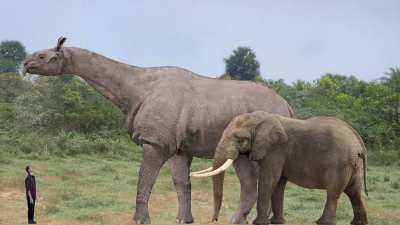
On both land and water, the largest animals are all mammals.
At 100 feet long and 200 tons, not only is the blue whale the biggest mammal in the world, but it’s also the largest vertebrate animal that has ever lived. Not even the largest dinosaurs approached it in bulk. Some titanosaurs were over 100 feet long, but they didn’t weigh 200 tons. Fittingly, the blue whale is also the loudest animal on earth. This cetacean can vocalize at 180 decibels, enough to render most other animals deaf.
The largest land-dwelling mammal on earth, at seven tons, the African elephant is smaller than the blue whale for good reason: The buoyancy of water helps to counteract the blue whale’s weight, and elephants are terrestrial. One reason the African elephant has enormous ears is to help dissipate its internal body heat. A warm-blooded, seven-ton mammal generates a lot of calories.
How can the biggest dolphin be a whale? Killer whales, also known as orcas, are classified as dolphins rather than whales. At six or seven tons, male orcas are bigger than the largest sharks, which means that killer whales, rather than great white sharks, are the atop predators of the oceans. Sharks have a more fearsome reputation because very few humans have been killed by killer whales.
Even-toed ungulates, or artiodactyls, are a widespread family of plant-eating mammals that includes deer, pigs, cows, and the biggest cleft-hoofed mammal, the common hippopotamus. The pygmy hippopotamus doesn’t approach its cousin’s five-ton heft. You could make a case for another even-toed creature, the giraffe, which is much taller than a hippo, but they weigh only two tons.
Perissodactyls, or odd-toed ungulates, aren’t as diverse as their even-toed cousins. This family consists of horses, zebras, and tapirs on the one hand and rhinoceroses on the other. The biggest perissodactyl is the white rhinoceros, which at five tons rivals Pleistocene rhinoceros ancestors such as the Elasmotherium. There are two types of white rhinos, the southern white rhinoceros and the northern white Rhinoceros; it’s easy to figure in what part of Africa they reside.
At up to four tons, not only is the southern elephant seal the biggest pinniped alive, but it’s also the biggest terrestrial meat-eating mammal, outweighing the largest lions, tigers, and bears. Male southern elephant seals vastly outweigh females, which top out at two tons. Like blue whales, male elephant seals are extraordinarily loud; they bellow their sexual availability from miles away.
If you’re under the illusion that polar bears, grizzly bears, and pandas are comparable in size, you’re wrong. Polar bears are by far the biggest—and deadliest—ursines. The largest males can reach a height of 10 feet and weigh up to a ton. The only bear that comes close is the kodiak bear; some males can reach 1,500 pounds.
The sirenians, the family of aquatic mammals that includes manatees and dugongs, are distantly related to pinnipeds and share many characteristics. At 13 feet long and 1,300 pounds, the West Indian manatee is the biggest sirenian by an accident of history: A bigger member of this breed, Steller’s sea cow, went extinct in the 18th century. Some of them weighed 10 tons.
The genus Equus comprises not only horses but also donkeys, asses, and zebras. While some domesticated horses exceed 2,000 pounds, Grevy’s zebra is the world’s largest wild equid; adults reach half a ton. Like many other animals on this list, Grevy’s Zebra is nearing extinction; there are probably fewer than 5,000 in scattered habitats in Kenya and Ethiopia.
How big is the giant forest hog? This 600-pound pig has been known to chase African hyenas from their kill, though it’s sometimes preyed on by the largest African leopards. Despite its size, the giant forest hog is relatively gentle. It is easily tamed, if not outright domesticated, and can live alongside humans. It’s mostly a herbivore, scavenging meals only when it’s especially hungry.
Male Siberian tigers weigh a whopping 500 to 600 pounds; females reach 300 to 400 pounds. Only 500 or so Siberian tigers still live in eastern Russia, and continuing ecological pressure may strip this big cat of its title. Some naturalists claim that Bengal tigers have surpassed their Siberian relatives, since they’re not as endangered and are better fed. There may be as many as 2,000 Bengal tigers in India and Bangladesh.
There are two contestants for world’s largest primate: the eastern lowland gorilla and the western lowland gorilla. Both live in the Congo, and by most accounts, the 400-pound eastern variety has the edge on its 350-pound western cousin, though western lowland gorillas outnumber the eastern variety by a 20-to-1 ratio.
Credit : Thoughtco.com
Picture Credit : Google




